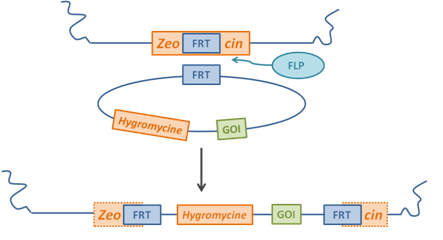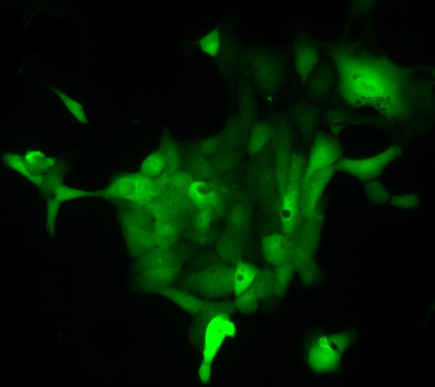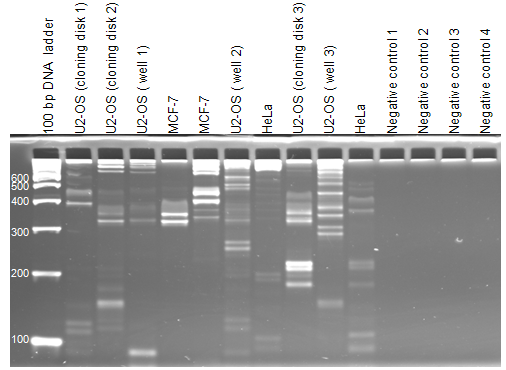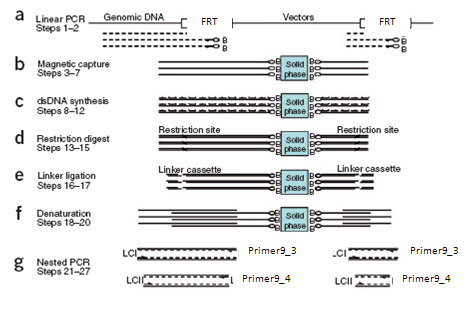Team:Heidelberg/stables
From 2009.igem.org
Stable Cell LineAbstractThe one problem that is always faced when measuring any construct or device in mammalian cells is the fact that the transfection rate is not always constant. Thus, one never knows how many copies of a construct are actually in the cell. This is why we attempted to create a system that allows a controled integration of our constructs into the genome. To accomplish this we used the FRT/Flp system which is based on homologous recombination by the enzyme flippase at a specific sequence – the FRT site [1]. One of those sequences is on a plasmid that is integrated randomly, but stably into the genome by antibiotic (Zeocin) selection. The other sequence is on the plasmid that contains the construct to be tested. Thus it would be possible to integrate at a specific site on the genome and select cells with the construct via a second antibiotic (Hygromycin). Additionally, the stable integration of an FRT site into the genome allows the characterization of the inserted constructs in the same genomic context thereby providing a normalization of the expression. Lastly, this integration site can also be located by LAM-PCR. IntroductionThe FRT/Flp system originates from yeast. The eukaryotic site-specific recombinase FLP is originally encoded by the multicopy yeast plasmid 2µ circle DNA that is common to many yeast strains [2][3]. Naturally, the cleavage and recombination takes place at an 8 bp spacer that is on either side enclosed by two inverted repeats of 599 bp in length. For FLP-mediated recombination only 13 bp of each 599 bp repeat adjacent to the spacer and the spacer itself are neccessary (see Fig. 1 sequences 2 and 3). Additionaly, most of the time another 13 bp repeat occurs immediately  Fig. 2: Priniciple of FRT/Flp recombination. The integration of the GOI is realized by transfecting the cells with both the FRT plasmid containing the GOI and a plasmid which codes for the enzyme flippase. The integration processs starting at the 8 bp spacer sequence of the FRT-sites occurs via Flip mediated homologous recombination. The process includes the destruction of the genomic Zeocin resistance and the integration of the Hygromycin resistance originally encoded on the plasmid, thus leading to new selection conditions for stable clones. upstream of the 5’ repeat (see Fig. 1 sequence 1). The spacer contains the cleavage site and is thus very sensitive to alterations either in length or in sequence. Moreover its asymmetry alone determines the orientation of the FLP recombination site [2].
Integrating one of those FLP recognition target sites (FRT site) stably into the genome and having another one on a plasmid which also contains the construct of interest will allow a controlled integration at that specific site by cotransfecting with an FLP encoding plasmid. Figure 2 illustrates the nature of this integration.
ResultsWe attempted to make a cell line with an FRT site by using the pFRT/lacZeo plasmid (Invitrogen). After transfecting HeLa, U2-OS and MCF-7 cells with the mentioned pFRT/lacZeo plasmid by using the Effectene kit (Qiagen) we selected cells that stably integrated the plasmid by adding Zeocin (100 μg/ml) to the culture medium (DMEM+++). After several days, cells with a Zeocin resistance will have grown up in foci that should originate from one single cell. Those foci were then picked as described in the cell culture methods. They were expanded into culture flasks and aliquots were frozen. After DNA extraction by use of the High Pure PCR Template Preparation Kit (Roche), LAM-PCR was carried out to localize the integration sites on the genome. Cotransfection of the plasmids pOG44 (encodes for FLP) and p55 (contains CMV promoter and GFP) at a ratio of 9:1 led to the integration of a GFP with a CMV promoter in some of the cells. After this cotransfection the cells were kept under Hygromycine pressure (200 µg/ml). There is no promoter in front of the resistence gene for Hygromycine so that cells that randomly and stably integrate the plasmid (as was done for the pFRT/lacZeo) do not express the resistance. Again, foci (see Fig. 3) were visible after several days. To properly characterize the integration sites of the pFRT/lacZeo plasmid in the genome we performed LAM-PCR at M. Schmidt's lab (see reference 5 for details) at the nct (national center for tumor diseases) in Heidelberg. Thereby we confirmed that we were able to generate HeLa, MCF-7 and U2-OS cells that stably integrated the FRT-site into their genome. For each cell line there are several bands visible (see Fig. 4). Since the number of bands correlates with the number of unique integration sites [5] there must have been more than one integration of the FRT-vector into the genome of the cells. DiscussionOur experiment showed that it is possible to generate cell lines with stable FRT sites. We are aware that our cell lines with multiple FRT sites are not ideal for the characterization of promoters. Nevertheless, we are convinced that a cell line that contains a single integration site can be generated and that it would be very valuable for standardized characterization of BioBrick parts in eukaryotes. Even though those characterizations are more time consuming due to the Hygromycine selection, they are of advantage once established, because the construct cannot be washed out as is observed when measuring transiently transfected cells. Measurements with our cell lines with multiple integration sites are also possible and favorable over transiently transfected cell lines. For one, it is expected that the number of construct integrations is statistically distributed. Furthermore, one can determine the number of constructs integrated. Since the genomic surroundings of the integration sites can be characterized by LAM-PCR, another (regular) PCR with one primer that is located on the genome and one that is on the other side of the gene of interest (GOI) can be carried out. To generate a cell line with only one integration site, the pFRT/lacZeo should have been linearized before transfection. That way, the transfection efficiency and thus the chance to stably integrate more than one copy would have been lower. Also linearization of the plasmid is favorable for LAM-PCR, because the sequences directly adjacent to the genomic DNA would be known. Although being very time-consuming, another attempt to create a cell line that stably integrated only one FRT-site would have a great impact for the synthetic biology community. Detailed MethodsLAM-PCR In order to determine where the plasmid containing the FRT-site is integrated into the genome, LAM-PCR is applied. This method established by Schmidt et al. can be used for identifying all unknown DNA sequences adjacent to known DNA-sequences.Based on linear amplification-mediated PCR it allows for amplifying the sequences flanking the integrated vector thus supplying the information which is needed for alignment with the host genome.
The procedure starts with linear PCR (Fig 5.a), which is carried out twice with 50 - cycles for each reaction. Primers used in PCR are labeled with biotin, which has a high affinity to Streptavidin [4]. By coupling Streptavidin to magnetic beats, removal of non-target DNA can be achieved via magnetic selection: newly synthesized single strands will bind via primer to the magnetic beads and can then be captured with MPC (Magnetic particle concentrator). The same kind of selection is used for the subsequent steps. After linear amplification complementary double strands are synthesized by hexanucleotide priming: a hexanucleotide mixture, dNTPS and Polymerase are added to the single stranded PCR-products. Hexanucleotides will prime to the single stranded DNA and polymerase will fill the gaps in between (Fig. 5.c) Those double strands are cut with restriction enzymes and a linker cassette with known sequence is ligated to the genomic end of the fragments which sequences are unknown (Fig. 5.d,e). This step is followed by denaturation of the double stranded DNA composed of linker cassette, genomic DNA and vector DNA by sodium hydroxid. The resulting single stranded DNA is then amplified by exponential PCR, using primers that prime to linker cassette and vector DNA. Another denaturation and a second exponential PCR is carried out (Fig. 5.f,g). PCR-products are visualized by separation on a 2% agarose gel. For a detailed description see [5]References[1] Zhou H. Development of site-specific integration system to high-level expression recombinant proteins in CHO cells. Chinese journal of biotechnology 23: 756-62 (2007). [2] Andrews B. J., Proteau G. A., Beatty L. G. & Sadowski P. D. The FLP Recombinase of the 2μ Circle DNA of Yeast: Interaction with Its Target Sequences. Cell 40: 795-803 (1985). [3] Senecoff J. F., Bruckner R. C. & Cox M. M. The FLP recombinase of the yeast 2-μ plasmid: Characterization of its recombination site. Proc. Nati. Acad. Sci. USA 82: 7270-7274 (1985). [4] Holmberg A., Blomstergren A., Nord O., Lukacs M., Lundeberg J. & Uhlén M. The biotin-streptavidin interaction can be reversibly broken using water at elevated temperatures. Electrophoresis 26(3): 501-10 (2005). [5] Schmidt M., Schwarzwaelder K., Bartholomae C., Zaoui K., Ball B.,Pilz I.,Braun S.,Glimm H.,von Kalle C., High-resolution insertion-site analysis by linear amplification–mediated PCR (LAM-PCR). Nature Methods 4(12): 1051-1057 (2005).
|
 "
"



